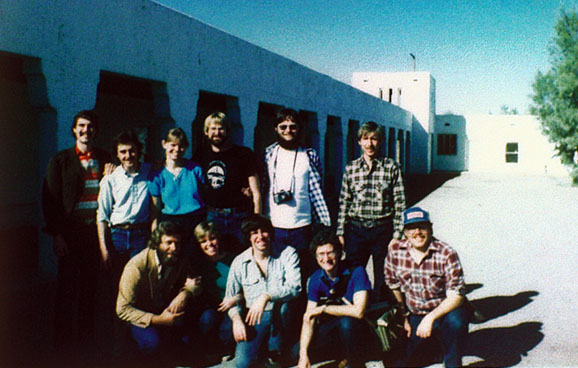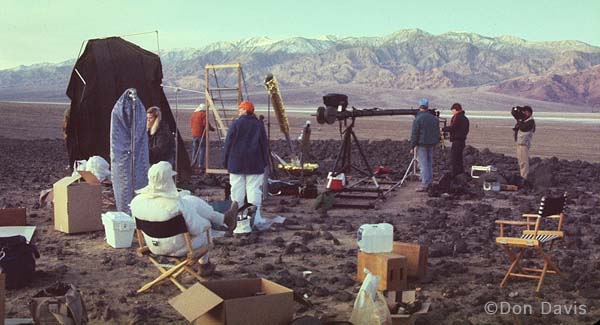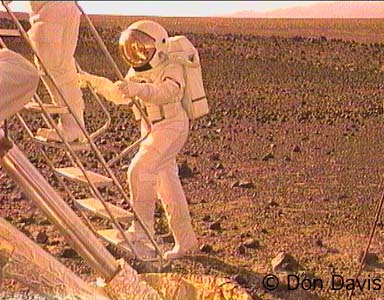Mars Hill
-The continuing story
 In
late 1983 the second gathering of space artists was put together,
largely through the efforts of Michael Carroll, at Death valley,
California. We stayed at the windswept Amargosa Hotel about 20
minutes east of the Valley itself. Some of the participants gathered
for this Polaroid.
In
late 1983 the second gathering of space artists was put together,
largely through the efforts of Michael Carroll, at Death valley,
California. We stayed at the windswept Amargosa Hotel about 20
minutes east of the Valley itself. Some of the participants gathered
for this Polaroid.
Standing Left to right: Kurt Burmann,
Andy Chaikin, Marilyn Vicary, Michael Carroll, Don Davis, Bob
Kline. In front: Jim Hervat, Pam Lee, Joel Hagen, David Campbell,
Rick Sternbach.
Another more complete group photo
appears here.
It was at this 'workshop' that
the International Association of Astronomical Artists came to
be.
Upon leaving the narrow and
at times claustrophobic 'Artists Drive' one sees nearly dead ahead
a low hill covered with broken and wind eroded volcanic rocks.
This was informally named Mars Hill by the participants of the
workshop because of the resemblance of the surface textures to
those seen by the Viking 2 lander.
After some 1991 tests of a Russian Mars rover,
Alan Silverstein working with the Planetary Society made a formal
proposal to the U.S. Geological Survey to have the feature formally
named Mars Hill, which was accepted. Now the name given by a group
of artists and later a team of planetary scientists will forever
be on the maps!

From the top of the hill the resemblance
is particularly striking, and as I stood there and shot a panorama
of Polaroids I was already seeing in my 'minds eye' the scene
as part of the rim of a flat bottomed Martian crater.

I later drew a grid over the mosaic,
carefully transplanted the relevant detail to an art board in
black and white paint, then added the mars specific details and
colors. I added some rippled sand dunes.
'Mars Hill 'thus provided the starting
point for a detailed visualization of our neighbor world, using
for reference an Earthly 'analog' to Martian scenery.

Mars Hill has since been used to
test Mars rover vehicles, and even to film a 1991 episode of the
Public Broadcasting show 'Space Age' depicting the first steps
on Mars.


A full scale landing leg and ladder rig
were hauled to the site, with space suit costumes worn by sweltering
volunteers from the WQED Science Effects unit. Later I learned
another show used the same location and filmed almost shot for
shot the same sequences.
Unfortunately such activities have
dislodged the delicate 'desert pavement' mosaic like carpet of
fine rocks resting on the powdery lower soil, and obvious scars
of these setups are evident in aerial views. The rangers were
wise to restrict filming to the lower rise next to the higher
and rockier main hill from which the panorama was shot.

 In
late 1983 the second gathering of space artists was put together,
largely through the efforts of Michael Carroll, at Death valley,
California. We stayed at the windswept Amargosa Hotel about 20
minutes east of the Valley itself. Some of the participants gathered
for this Polaroid.
In
late 1983 the second gathering of space artists was put together,
largely through the efforts of Michael Carroll, at Death valley,
California. We stayed at the windswept Amargosa Hotel about 20
minutes east of the Valley itself. Some of the participants gathered
for this Polaroid.



